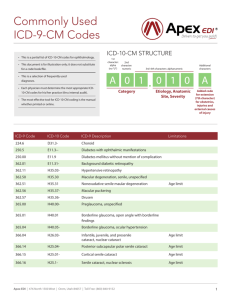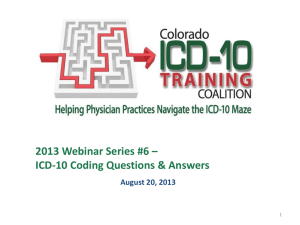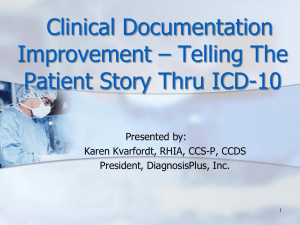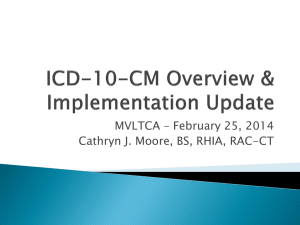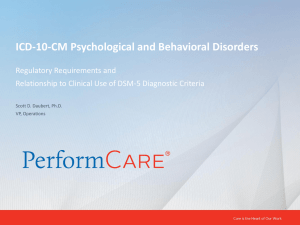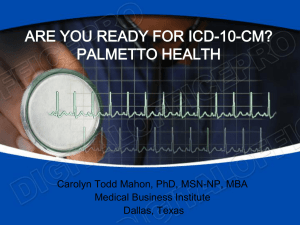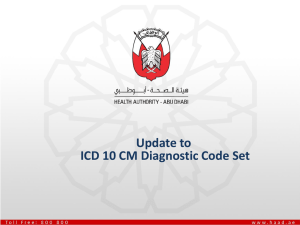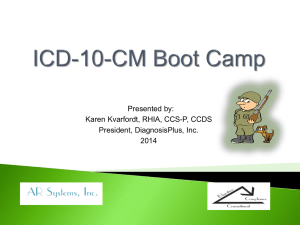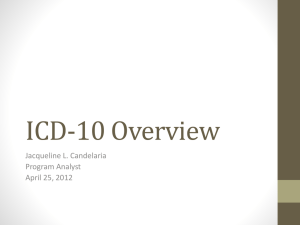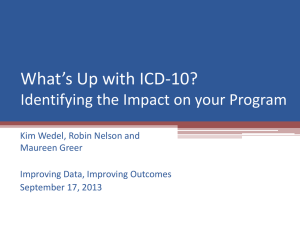ICD 10 - Bayhealth Medical Center
advertisement
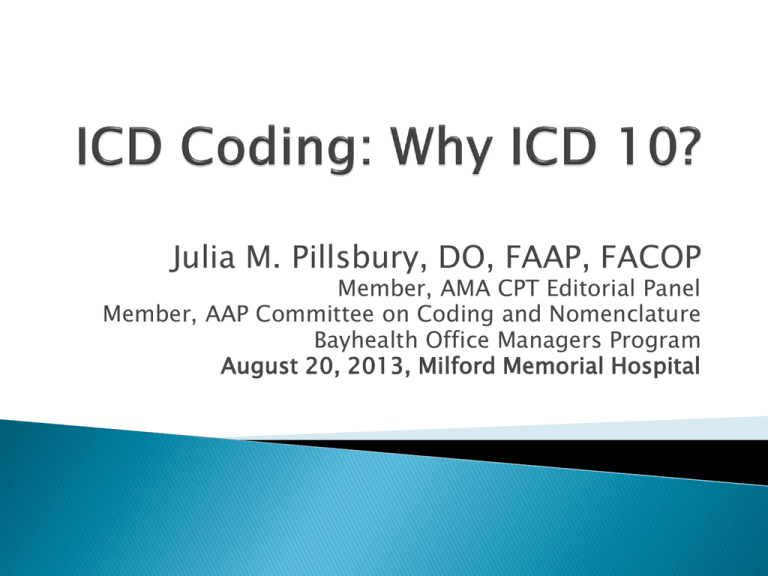
Julia M. Pillsbury, DO, FAAP, FACOP Member, AMA CPT Editorial Panel Member, AAP Committee on Coding and Nomenclature Bayhealth Office Managers Program August 20, 2013, Milford Memorial Hospital In the past 12 months, I have had a significant financial interest or other relationship with the manufacturer(s) of the following product(s) or provider(s) of the following service(s) that will be discussed in my presentation. AMA CPT Editorial Panel Editorial Board: AAP Pediatric Coding Newsletter AAP Committee on Coding and Nomenclature Upon completion of this presentation, the participant will be able to: 1. Describe the purpose of the International Classification of Diseases, Tenth Revision, Clinical Modification (ICD10 -CM) 2. Describe the similarities and differences in the structure and format of ICD10-CM. 3. Understand the importance of documentation in using ICD10-CM. International Classification of Diseases (ICD) is an official publication of the World Health Organization (WHO) ◦ Part of the WHO Family of International Classifications International Classification of Functioning, Disability and Health International Classification of Health Interventions International Classification of Diseases for Oncology Primary purpose is for epidemiological tracking of illness and injury ICD has been used in the US since 1949 (ICD-6) ◦ Revised every 8-10 years First US adaption was by the US Public Health Service with ICD-7 Current US version, ICD-9-CM (clinical modification), is a public-private collaboration (cooperating parties) ◦ ◦ ◦ ◦ National Center for Health Statistics/CDC (NCHS) Centers for Medicare and Medicaid Services (CMS) American Hospital Association American Health Information Management Association (AHIMA) Formerly the American Medical Record Association HIPAA standard for morbidity and mortality reporting Accurate diagnosis coding is the basis for obtaining medical data for: Reporting and trending vital health statistics Evaluating medical processes and outcomes Reporting data to organizations: quality and cost effectiveness Identifying public health issues and concerns Identifying ways to improve the safety and quality of care Evaluating medical necessity when adjudicating claims ICD–9–CM = International Classification of Diseases, Ninth Edition, Clinical Modification Developed in early 1970’s ICD-9-CM has been used for morbidity and mortality reporting since 1979 in US. ICD-9-CM is divided into 3 chapters ◦ Chapters 1 and 2 have morbidity/mortality codes NCHS (CDC) has primary responsibility ◦ Chapter 3 is inpatient hospital resource codes CMS has primary responsibility ICD–10–CM/PCS = International Classification of Diseases, Tenth Edition, Clinical Modification/ Procedure Coding System Developed in 1989, released in 1994. ICD-10 has been in use for mortality reporting in the US since January 1, 1999. 2 Parts: ICD-10-CM = Diagnosis classification system developed the Centers for Disease Control and Prevention ICD-10-PCS = Procedure classification system developed by the CMS for use in the U.S. for inpatient hospitals ONLY. CMS published the Final Rule for US clinical modification (ICD-10-CM) January 16, 2009. Required implementation on October 1, 2013. (Deferred until October 1, 2014.) ◦ ICD-9-CM will no longer be accepted for encounters starting on that date. ICD-10-CM will replace ICD-9-CM Volumes 1 (tabular) and 2 (index). ICD-10-PCS will replace ICD-9-CM Volume 3 (inpatient hospital resource utilization) ◦ ICD-10-PCS does not replace CPT or HCPCS. ICD-9-CM is no longer supported by WHO. ICD 9 cannot be expanded in the way technology is moving. ICD 9 cannot keep pace with our expanding knowledge of disease and treatment. ICD-9 contains “outdated and obsolete terminology …that produces inaccurate and limited data, and is inconsistent with current medical practice.” ICD-10 includes updated medical terminology and classification of diseases. ICD-10 incorporates much greater specificity and clinical information. ICD-10 will improve the quality of patient care and health data…better public health surveillance. Implementation was delayed from October 1, 2013 until October 1, 2014. The big question: Will more delays occur? ICD-10 has been in use for mortality reporting in the US since January 1, 1999. Current code sets are “frozen” until October 1, 2015 to reduce annual updates/changes. Encounters that take place on or after October 1, 2014 are reported with ICD-10-CM codes Encounters that take place before October 1, 2014 are reported with ICD-9-CM codes You will have to run simultaneous systems of ICD-9 and ICD-10 until all your claims from before October 1, 2014 have cleared and for non-HIPAA compliant claims. * ICD-10 only applies to patients covered under HIPAA, so Workers Compensation patients, who aren't covered under HIPAA, will still be billed under ICD-9. Look at the current resources that exist. Review your EMR/EHR programs to verify they are ICD-10-CM ready and what steps you have to take to update If you don’t have an EMR or billing program look in to one that supports ICD-10-CM ◦ Capability to run both codes a bonus Look at costs of the change and start planning for that now. Budget costs of the change. Estimated cost $83,000.00 for a small practice up to $283,000.00 for a 10 physician practice. Review contracts with health plans and see what additional information they need or what will be changing. Test systems and procedures before October 2014 to make sure your office is ready to go. Update forms, documentation, and internal processes. Begin now! Perform a readiness assessment. Is your practice management system ready? If not, when will it be? Are your payers ready? Need to test with vendors ASAP. Anticipate a reduction in cash flow. Training impacts productivity. Begin saving for cash flow issues or arrange a bank LOC. ICD-10 EDUCATION! Educate your providers and staff! Encourage your providers to document and use more specific codes. Especially those who tend to use unspecified codes or whose documentation leads to an “unspecified”code. Most payers said they won't reimburse for unspecified codes. Work with those providers on their documentation and in areas where you know more documentation is needed (e.g. Otitis Media). Develop an education plan. Begin training 3-6 months prior to implementation. Anticipate a minimum of 4 hours training time/employee. 20-40 hours for coders. Specificity requires more clinical knowledge e.g. Anatomy and physiology. Physician training should focus on documentation concepts. Alphabetical listing. Tabular listing. Code First/Use Additional Code Notations rules are unchanged. Can still use symptoms. Used when certain conditions have both an underlying etiology and multiple body system manifestations. Requires the underlying condition be sequenced first followed by the manifestation. ◦ ICD-10-CM use same coding convention as ICD- 9-CM. + “Use additional code" notation is listed with the etiology code. * “Code first” notation is listed with the manifestation code. Category: D57 Sickle-cell disorders (etiology code) +Use additional code for any associated fever (R50.81) For a patient with Sickle cell SC disease with fever and no pain report ◦ D57.20 Sickle-cell/Hb-C disease without crisis (underlying etiology, primary code) ◦ R50.81 Fever presenting with conditions classified elsewhere (manifestation, contributing diagnosis) ICD-9-CM Diagnosis Codes 3-5 digits First digit is numeric or alpha (E or V). Digits 2-5 are numeric Decimal is used after third character. ICD-10-CM Diagnosis Codes: 3-7 digits Digit 1 is alpha Digit 2 is numeric Digit 3-7 are alpha or numeric (alpha digits are not case sensitive) Decimal is used after third character. Primarily, changes in ICD-10-CM are in its organization and structure, code composition and level of detail. ICD-10 requires much greater detail on location of ailments, cause and type, and complications or manifestations compared with ICD-9. ICD-9 expands from ~13,500 to ~68,000 codes in ICD-10. Codes have 3 to 5 placeholders 17 Chapters: all placeholders are numeric Supplemental chapters: first placeholder is alpha (V or E), remainder are numeric. 462 Acute pharyngitis 780.60 Fever, unspecified V20.2 Routine infant or child health check E914 Foreign body accidentally entering eye and adnexa Codes may be 3, 4, 5, 6 or 7 characters Placeholder 1 is alpha (except U) Placeholders 2 and 3 are numeric Placeholders 4-7 are alpha or numeric J02 Acute pharyngitis R50.9 Fever, unspecified Z00.129 Encounter for routine child health examination without abnormal findings T15.90xA Foreign body on external eye, part unspecified, unspecified eye, initial encounter Tabular List contains categories (3 digits), subcategories and codes Subcategories are 4 characters Codes may be 3, 4, 5, 6 or 7 characters. ◦ 5-6th character shows anatomical site or additional clinical details ◦ 7th character provides details of encounter, e.g. initial or subsequent visit for injuries and poisonings. ◦ Code to the highest degree of specificity ◦ “x” is used in certain cases as a 5th or 6th character placeholder All placeholders of an applicable code must be reported. Category A= A N Etiology, anatomical site, severity N A/N A/N A/N A = Alpha N = Numeric Extension A/N Placeholder “x” is used ◦ as a 5th or 6th character placeholder at certain codes to allow for future expansion. ◦ When a base 3-5 character codes requires a 7th digit √x7 means “x” is placed in otherwise unfilled placeholder as the 5th or 6th character placeholder in an otherwise 4-5 digit code. th Base code S50.02 Contusion of left elbow Base code S47.1 Crushing injury of right shoulder and upper arm ◦ Use S50.02xD to report a subsequent encounter ◦ Use S47.1xxA to report the initial encounter 21 Chapters ◦ No Supplemental Chapters 2 New Chapters ◦ Diseases of the Eye and Adnexa (Chapter 7) ◦ Diseases of the Ear and Mastoid Process (Chapter 8) Moved Immunity Diseases from “Endocrine, Nutritional and Metabolic Disorders” to “Diseases of the Blood” ◦ Diseases of the Blood and Blood Forming Organs and Certain Disorders Involving the Immune Mechanism (Chapter 3) Laterality (left, right, bilateral) The use of combination codes, e.g. poisoning, intentional self-harm. Obstetric codes identify trimester. Inclusion of clinical concepts which do not exist in ICD-9-CM e.g. blood type. A number of codes have been significantly expanded e.g. injuries, diabetes, substance abuse, postoperative complications. Codes for postoperative complications have been expanded and a distinction made between intraoperative complications and post-procedural disorders. Excludes 1 – Indicates that the code excluded should never be used with the code where the note is located (do not report both codes) e.g. congenital vs. acquired conditions. Exclusion1 A05.1 Botulism food poisoning Botulism NOS ◦ Classical foodborne intoxication due to Clostridium botulinum ◦ Excludes1: infant botulism (A48.51) wound botulism (A48.52) Excludes 2 – Indicates that the condition excluded is not part of the given condition represented by the code but a patient may have both conditions at the same time, in which case both codes may be assigned together (both codes are reported to capture both conditions). Exclusion2 A38 Scarlet fever ◦ Includes: scarlatina ◦ Excludes2: streptococcal sore throat (J02.0) Injuries are grouped by anatomic site rather than type of injury. Certain diseases have been reclassified to different chapters or sections in order to reflect current medical knowledge. New code definitions. May be reported with up to 7 characters Depending on specific code ◦ 5th placeholder designates location ◦ 6th placeholder denotes laterality and/or displacement for fractures ◦ 7th placeholder specifies additional information related to the encounter Injuries are coded by “episode of care”. A - initial encounter D - subsequent encounter S - sequela S60 Superficial injury of wrist, hand and fingers* S60.4 Other superficial injuries of other fingers S60.45 Superficial foreign body [splinter] of fingers** S60.451 Superficial foreign body [splinter] of left index finger S60.451A Superficial foreign body [splinter] of left index finger, initial encounter*** Required to use the 7 digit code for this condition *category, **subcategory, ***code A - initial encounter for closed fracture B - initial encounter for open fracture D - subsequent encounter for fracture with routine healing G - subsequent encounter for fracture with delayed healing K - subsequent encounter for fracture with nonunion P - subsequent encounter for fracture with malunion S - sequela ICD-9: Fracture of Clavicle (requires a 5th digit) 4th digit denotes closed vs. open 5th digit denotes the specific area of the fx 810.00 810.01 810.02 810.03 810.10 810.11 810.12 810.13 ,closed, unspecified part , closed, sternal end of clavicle , closed, shaft of clavicle , closed, acromial end of clavicle , open, unspecified part , open, sternal end of clavicle , open, shaft of clavicle , open, acromial end of clavicle ◦ ICD-10-CM requires 7 digits: ◦ 5th placeholder designates location ◦ 6th placeholder denotes laterality and/or displacement for fractures ◦ 7th placeholder specifies additional information related to the encounter S42.011A: Anterior displaced (closed) fx of sternal end of right clavicle, initial encounter S42.015D: Posterior displaced fx of sternal end of left clavicle, subsequent visit, with routine healing S42.017A: Nondisplaced fracture of sternal end of right clavicle, initial encounter for closed fracture S42.025D: Nondisplaced fracture of shaft of left clavicle, subsequent encounter for fracture with routine healing S42.031B: Displaced (open) fracture of lateral (acromial) end of right clavicle, initial encounter S42.031K: Displaced fracture of lateral end of right clavicle, subsequent encounter for fracture with nonunion Fractures now subdivided: ◦ Traumatic ◦ Pathological List the underlying medical condition such as Osteogenesis Imperfecta as cause of fracture. Diabetes now combined with manifestations or underlying conditions. Drug and Chemical Table has new category ◦ “Under-dosing” Morphology appendix was deleted. General Equivalency Mapping (GEM) ◦ Purpose is to “convert” ICD-9-CM codes to ICD10-CM codes. Developed by CMS and CDC. Crosswalks common ICD-9 codes to ICD-10 codes. Use term “crosswalk” very loosely as most codes do not simply “crosswalk” over. (Need to do forward mapping of ICD-9 to ICD-10 and backward mapping from ICD-10 to ICD-9 to verify code choice/selection.) There are some straightforward crosswalks ICD-9 to ICD-10 Mostly these are in the infectious disease, neoplasm, eye, and ears code Some ICD-9 codes have more specificity then their ICD-10 equivalents In ICD-10, some conditions were combined, where in ICD-9 there were reported separately Both the CDC and CMS offer this tool. Use the CDC for office-based coding. The mappings are free of charge and are in the public domain. https://www.cms.gov/icd10/ Mapping links concepts in the two code sets without consideration of patient medical record documentation. Mapping Is not the same as correct coding. Some codes will have the same wording between the 2 codes sets and basically “crosswalk” over. ICD-9-CM to ICD-10-CM 003.21 Salmonella meningitis = A02.21 Salmonella meningitis 745.2 Tetralogy of Fallot = Q21.3 Tetralogy of Fallot Some codes won’t match because of changes in definitions in ICD-10-CM. ICD-9-CM 764.0 "Light-for-dates" without mention of fetal malnutrition birthweight 2,500 grams and over to ICD-10-CM ≠ No diagnosis for infant with this birthweight • code set is for weights <2500 grams In some cases ICD-9-CM may have had certain specificities that are not being translated to ICD-10-CM. ICD-9-CM ICD-10-CM 010.90 Primary tuberculous infection, unspecified examination 010.91 Primary tuberculous infection, bacteriological/histological exam not done 010.92 Primary tuberculous infection, bacteriological/histological exam unknown (at present) 010.93 Primary tuberculous infection, tubercle bacilli found by microscopy 010.94 Primary tuberculous infection, tubercle bacilli found by bacterial culture 010.95 Primary tuberculous infection, tubercle bacilli confirmed histologically 010.96 Primary tuberculous infection, tubercle bacilli confirmed by other methods A15.7 Primary respiratory tuberculosis When there is more specificity in ICD-10, there may be multiple codes to describe the condition or disease. Increased physician documentation will be vital. ICD-9-CM Source to ICD-10-CM Target 599.72 Microscopic hematuria ≈ R31.1 Benign essential microscopic hematuria 599.72 Microscopic hematuria ≈ R31.2 Other microscopic hematuria New unique code for Type 2 diabetes ICD-9 250.00 250.02 250.12 Description ICD-10 DM w/o mention of complication: Type II or unspecified type, not stated as uncontrolled (.00) OR uncontrolled (.02) E11.9 DM w/ ketoacidosis: Type II or unspecified type E11.65 E11.65 Description Type 2 diabetes mellitus w/o complications Type 2 diabetes mellitus with hyperglycemia Type 2 diabetes mellitus with hyperglycemia Use additional code to identify complication 250.40 250.42 DM w/ renal manifestations: Type II or unspecified type, not stated as uncontrolled (.40) OR uncontrolled (.42) + Additional Code to Identify Manifestations E11.29 E11.21 and E11.65 Type 2 diabetes mellitus with other diabetic kidney complication Type 2 diabetes mellitus with diabetic nephropathy Type 2 diabetes mellitus with hyperglycemia A combination code may contain more then one diagnosis or concept ◦ Chronic condition with acute manifestation G40.911 Epilepsy, unspecified, intractable, with status epilepticus ◦ Two concurrent acute conditions R65.21 Severe sepsis with septic shock ◦ Acute condition with external cause T39.012A Poisoning by aspirin, intentional self-harm When ICD-10-CM contains a combination code, it will relate back to 2 distinct ICD-9-CM codes What used to require 2 or more codes, now only requires a single code. ICD-10-CM Source to ICD-9-CM Target R65.21 Severe sepsis with septic shock ≈ 995.92 Severe sepsis and 785.52 Septic shock Encounter for healthcare exams Must be recognized by third party payers. May be used as primary diagnosis. Z00.110 Health supervision (health check) for newborn under 8 days Z00.111 Health supervision (health check) for newborn 8 to 28 days old ◦ weight check Z00.129 Routine child health check without abnormal findings Z00.121 Routine child health check with abnormal findings ◦ use additional code to identify abnormal findings Z23 Encounter for immunization ◦ code first any routine childhood examination REGISTER NOW: CMS National Provider Call - ICD-10 Basics MLN Connects™ Thursday, August 22, 2013 1:30 p.m. to 3:00 p.m. To Register: Visit MLN Connects Upcoming Calls. Space may be limited, register early. You write this AOM OME Acute OME The listed diagnosis is H66.90 Otitis media, unspecified, unspecified ear H65.90 Unspecified nonsuppurative otitis media, unspecified ear H66.90 Otitis media, unspecified, unspecified ear ICD-9-CM 382.00 Acute suppurative otitis media (ASOM) without spontaneous rupture of ear drum ICD-10-CM Acute suppurative otitis media without spontaneous rupture of ear drum ◦ ◦ ◦ ◦ ◦ ◦ ◦ ◦ H66.001, H66.002, H66.003, H66.004, H66.005, H66.006, H66.007, H66.009, right ear left ear bilateral recurrent, right ear recurrent, left ear recurrent, bilateral recurrent, unspecified ear unspecified ear Acute serous otitis media ◦ ◦ ◦ ◦ ◦ ◦ ◦ ◦ H65.00, H65.01, H65.02, H65.03, H65.04, H65.05, H65.06, H65.07, unspecified ear right ear left ear bilateral recurrent, right ear recurrent, left ear recurrent, bilateral recurrent, unspecified ear You write this Reactive airway disease Respiratory distress The listed diagnosis is J45.909 Unspecified asthma, uncomplicated or J45.998 Other asthma R06.09 Other forms of dyspnea or R06.89 Other abnormalities of breathing or R06.00 Dyspnea unspecified Acute bronchospasm (J98.01) Asthma: J45 Asthma (requires 5 digits) ◦ Now can code based on severity (mild, moderate, severe) ◦ ◦ ◦ ◦ ◦ ◦ ◦ ◦ ◦ ◦ Now can code intermittent versus persistent J45.20 Mild intermittent, uncomplicated J45.21 Mild intermittent with (acute) exacerbation J45.22 Mild intermittent with status asthmaticus J45.30 Mild persistent, uncomplicated J45.31 Mild persistent with (acute) exacerbation J45.32 Mild persistent with status asthmaticus J45.40 Moderate persistent, uncomplicated J45.41 Moderate persistent with (acute) exacerbation J45.42 Moderate persistent with status asthmaticus Asthma ◦ ◦ ◦ ◦ ◦ ◦ ◦ ◦ J45.50 Severe persistent, uncomplicated J45.51 Severe persistent with (acute) exacerbation J45.52 Severe persistent with status asthmaticus J45.901 Unspecified asthma with (acute) exacerbation J45.902 Unspecified asthma with status asthmaticus J45.909 Unspecified asthma, uncomplicated J45.990 Exercise induced bronchospasm J45.991 Cough variant asthma Assessment: Basic description of findings Diagnosis: A concise technical description An assessment is not necessarily a diagnosis. Diagnosis needs to be easily ‘translated’ in to ICD terminology. An assessment can be helpful in supporting medical necessity and medical decision making. Child presents with vomiting, diarrhea and fever during Rotavirus season Is not significantly dehydrated, tolerates oral therapy without emesis Assessment: Findings are consistent with AGE cause by Rotavirus Diagnosis: Rotavirus AGE (A08.0) - * *R/O and suspected diagnosis should not be coded in the out-patient setting but can use clinical judgment to determine a diagnosis. Infectious gastroenteritis (A09) ◦ Gastroenteritis, presumed infectious ◦ Infectious diarrhea ◦ Diarrhea, presumed infectious Rotavirus enteritis (A08.0) Unspecified viral intestinal infection (A08.4) Allergic gastroenteritis (K52.2) ◦ When occurring with the same illness vomiting and diarrhea are considered “inherent” to gastroenteritis and should not be listed as separate diagnoses. 5 year-old child presents with asthma-like symptoms (cough, wheezing, retractions) that responds to a bronchodilator ◦ Has not been given a formal diagnosis of ‘asthma’ Assessment: cough and wheezing, probable RAD Diagnosis: Acute bronchospasm (J98.01) Flexible ◦ can quickly incorporate emerging diagnoses More specificity ◦ able to identify precise diagnosis Improves ability to measure health care services Supports improved public health surveillance Reflects advances in medicine and medical technology More room for expansion Samantha: I am Sam, Sam, you see, and I do so love this new ICD. Provider: That ICD, that ICD, I do not like that ICD! Samantha: Do you like to work for free? Provider: Can you code injury in a house? Can you code injury with a mouse? Samantha: I can code it in a house (Y92.019). I can code it with a mouse (W53.09XA). Provider: Can you code injury on a plane? Can you code injury on a train? Samantha: I can code it on a plane (Y92.813). I can code it on a train (Y92.815). I can code it in a house (Y92.019). I can code it with a mouse (W53.09XA). I do so love this ICD; it's so much better, can't you see? Provider: Can you code being hit by a baseball? Can you code falling down the stairs at the mall? Samantha: I can code being hit by a baseball (W21.03XA). I can code falling down the stairs at the mall (W10.9XXA, Y92.59). I can code it on a plane (Y92.813). I can code it on a train (Y92.815). I can code it in a house (Y92.019). I can code it with a mouse (W53.09XA). I do so love this ICD; it's so much better, can't you see? Provider: Now I see, this ICD. You have made it clear to me. We'll have clean claims and payment fast! ICD-10 is here at last! Garrison, Susan and Linker, Robin, ICD-10-CM Preparation Workshops, 2012 AMA CPT Symposium, November, 2011. Grider, Deborah J., Preparing for ICD-10-CM: make the Transition Manageable, AMA, 2010. Pittman, David, “Docs’ Charting Falls Short of ICD-10 Demands”, MedPage Today, 04132013. Linzer Sr., Jeffrey MD, FACEP, FAAP, AAP Liaison to the ICD Coordination & Maintenance Committee and Editorial Advisory Board, ICD-10-CM: It’s Not a Myth It’s Coming! February 9, 2012. https://www.cms.gov/icd10/ http://www.ahima.org/ For additional information go to the NCHS ICD-10-CM website cdc.gov/nchs/icd/icd10cm.htm ◦ 2010 Version of Documentation and User’s Guide, Diagnosis Code Set General Equivalence Mappings ◦ General Equivalence Mappings, Documentation for Technical Users Specialty society resources. Example: AAP Coding Hotline aapcodinghotline@aap.org is a resource for practitioners to submit coding questions and receive a response from AAP coders. AAP Coding Newsletter. Pediatric Code Crosswalk ICD-9 to ICD-10 Principles of Pediatric ICD-10-CM Coding AAP Pediatric Coding Newsletter™—proven coding solutions you can’t afford to miss! Now featuring a NEW monthly column on Transitioning to ICD-10-CM Month after month, AAP Pediatric Coding Newsletter™ helps you maximize payment, save time, and implement best business practices to support quality patient care. Included in this annual subscription product is print and online access to broad coverage of coding for pediatric primary care and subspecialty services Coding for Pediatrics 2013—new 18th edition of the number 1 pediatric coding and billing resource! For beginners and advanced coders alike, this is the first place to look for pediatric-specific, AAP-endorsed, peer-reviewed coding solutions…all new and updated Current Procedural Terminology (CPT®) and International Classification of Diseases, Ninth Revision, Clinical Modification (ICD-9-CM) pediatric codes…practical recommendations, tips, and techniques…and much more 2013 Pediatric ICD-9-CM Coding Pocket Guide—convenient goanywhere format! Streamline pediatric diagnosis coding with this newly revised reference. Here are the basic guidelines for selecting appropriate codes for commonly encountered pediatric diagnoses and diseases AAP Pediatric Coding Webinars www.aap.org/bookstore to order. Practice Management Online (PMO) (http://practice.aap.org) supports pediatricians in running a practice that is fiscally sound and efficient and provides quality health care to children and families.
